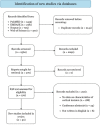Cortical incisions and transcortical approaches for intra-axial and intraventricular lesions: A scoping review
- PMID: 38628541
- PMCID: PMC11021096
- DOI: 10.25259/SNI_58_2024
Cortical incisions and transcortical approaches for intra-axial and intraventricular lesions: A scoping review
Abstract
Background: Transcortical approaches, encompassing various surgical corridors, have been employed to treat an array of intraparenchymal or intraventricular brain pathologies, including tumors, vascular malformations, infections, intracerebral hematomas, and epileptic surgery. Designing cortical incisions relies on the lesion location and characteristics, knowledge of eloquent functional anatomy, and advanced imaging such as tractography. Despite their widespread use in neurosurgery, there is a noticeable lack of systematic studies examining their common lobe access points, associated complications, and prevalent pathologies. This scoping review assesses current evidence to guide the selection of transcortical approaches for treating a variety of intracranial pathologies.
Methods: A scoping review was conducted using the PRISMA-ScR guidelines, searching PubMed, EMBASE, Scopus, and Web of Science. Studies were included if ≥5 patients operated on using transcortical approaches, with reported data on clinical features, treatments, and outcomes. Data analysis and synthesis were performed.
Results: A total of 50 articles encompassing 2604 patients were included in the study. The most common primary pathology was brain tumors (60.6%), particularly gliomas (87.4%). The transcortical-transtemporal approach was the most frequently identified cortical approach (70.48%), and the temporal lobe was the most accessed brain lobe (55.68%). The postoperative course outcomes were reported as good (55.52%), poor (28.38%), and death (14.62%).
Conclusion: Transcortical approaches are crucial techniques for managing a wide range of intracranial lesions, with the transcortical-transtemporal approach being the most common. According to the current literature, the selective choice of cortical incision and surgical corridor based on the lesion's pathology and anatomic-functional location correlates with acceptable functional outcomes.
Keywords: Intracranial lesions; Surgical approach; Transcortical approaches; Transcortical transtemporal.
Copyright: © 2024 Surgical Neurology International.
Conflict of interest statement
There are no conflicts of interest.
Figures



Similar articles
-
The transcortical equatorial approach for gliomas of the mesial temporal lobe: techniques and functional outcomes.J Neurosurg. 2019 Mar 1;130(3):822-830. doi: 10.3171/2017.10.JNS172055. Epub 2019 Mar 1. J Neurosurg. 2019. PMID: 29676697
-
Anatomical step-by-step dissection of common approaches to the third ventricle for trainees: surgical anatomy of the anterior transcortical and interhemispheric transcallosal approaches, surgical principles, and illustrative pediatric cases.Acta Neurochir (Wien). 2023 Sep;165(9):2421-2434. doi: 10.1007/s00701-023-05697-1. Epub 2023 Jul 7. Acta Neurochir (Wien). 2023. PMID: 37418043
-
Transcortical insular glioma resection: clinical outcome and predictors.J Neurosurg. 2018 Oct 19;131(3):706-716. doi: 10.3171/2018.4.JNS18424. Print 2019 Sep 1. J Neurosurg. 2018. PMID: 30485243
-
A proposed classification system for presigmoid approaches: a scoping review.J Neurosurg. 2023 Mar 10;139(4):965-971. doi: 10.3171/2023.2.JNS222227. Print 2023 Oct 1. J Neurosurg. 2023. PMID: 36905661
-
Surgical approaches for resection of third ventricle colloid cysts: meta-analysis.Neurosurg Rev. 2021 Dec;44(6):3029-3038. doi: 10.1007/s10143-021-01486-5. Epub 2021 Feb 15. Neurosurg Rev. 2021. PMID: 33590366 Review.
Cited by
-
Intraoperative neurovascular considerations for efficient intraventricular meningioma surgery: illustrative case.J Neurosurg Case Lessons. 2025 Jun 16;9(24):CASE2569. doi: 10.3171/CASE2569. Print 2025 Jun 16. J Neurosurg Case Lessons. 2025. PMID: 40523341 Free PMC article.
-
Paramedian transparietal approach to the lateral ventricle in a dominant hemisphere: how I do it.Acta Neurochir (Wien). 2024 Dec 3;166(1):493. doi: 10.1007/s00701-024-06382-7. Acta Neurochir (Wien). 2024. PMID: 39625589 Free PMC article.
-
A Combined Transtemporal and High-parietal Approach for Large Intraventricular Trigone Meningioma: A Case Series and Review of the Literature.NMC Case Rep J. 2025 Jun 11;12:267-273. doi: 10.2176/jns-nmc.2025-0031. eCollection 2025. NMC Case Rep J. 2025. PMID: 40599307 Free PMC article.
References
-
- Ali R, Englot DJ, Yu H, Naftel R, Haas KF, Konrad PE. Experience from 211 transcortical selective amygdalohippocampectomy procedures: Relevant surgical anatomy and review of the literature. Oper Neurosurg (Hagerstown) 2021;21:181–8. - PubMed
-
- Anderson RC, Ghatan S, Feldstein NA. Surgical approaches to tumors of the lateral ventricle. Neurosurg Clin. 2003;14:509–25. - PubMed
-
- Asgari S, Engelhorn T, Brondics A, Sandalcioglu IE, Stolke D. Transcortical or transcallosal approach to ventricle-associated lesions: A clinical study on the prognostic role of surgical approach. Neurosurg Rev. 2003;26:192–7. - PubMed
-
- Barrow DL, Dawson R. Surgical management of arteriovenous malformations in the region of the ventricular trigone. Neurosurgery. 1994;35:1046–54. - PubMed
Publication types
LinkOut - more resources
Full Text Sources
